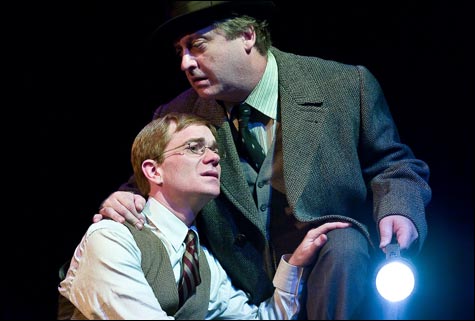
GHOST PLAY: And there’s little one can say about the malevolent title character without giving away the gimmick. |
Line up your goosebumps: Gloucester Stage is rushing Halloween with a bit of Victorian hokum entitled The Woman in Black (through September 14). Adapted from a 1983 ghost tale by novelist Susan Hill, Stephen Mallatratt’s two-man play adds meta-theatrics to the mystery swirling about Eel Marsh House, across Nine Lives Causeway, on the misty East Coast of England, where a young solicitor named Arthur Kipps is sent to sort out the affairs of a recently deceased dowager. In the novel, this “true story of haunting and evil, fear and confusion, horror and tragedy” is told in the first person by an older Kipps to counter the ghoulish exaggerations of his ghost-story-telling stepchildren. In the play, Kipps has hired an actor to help him turn his story into a performance that he hopes will exorcise the hangover willies of his unsettling youthful errand, if not its fateful after-effect. I must say it all struck me as tedious and silly, and the play-within-a-play trick really slows things down. But the work has been running for almost 20 years in London — can two decades worth of the satisfactorily spooked be wrong?
At Gloucester Stage, the show begins on a rudimentary stage thrust out from a squat, gilded proscenium. Furniture is blanketed. A few trunks are stacked. The rehearsal-ready set looks like a thing designed by Miss Havisham. (David Reynoso actually did the honors.) Quite suddenly the lights go up on Steven Barkhimer as an awkward older Kipps nervously clearing his throat before droning from a script as thick as the phone book. He is soon interrupted from the house by Shelley Bolman’s boyish but merciless actor coach, admonishing him to perk it up and threatening to make “an Irving” — not an Olivier or Gielgud — of him. Although Hill wrote her story in the 1980s, it’s clear she styled it after Victorian prose of the genre, with echoes of Charles Dickens and Henry, not to mention M.R., James. And Mallatratt retains the writerly, melodramatic feel of the narrative. But to me the tale, full of fog and fright and the vehicular equivalent of the headless horseman, sounds more like parody than the thing itself.

Barkhimer has some fun with Kipps’s gingerly attempts to be more rousing. But the recollector ultimately loses the part of himself. And the two men, abetted by atmospheric lighting and “recorded sound,” set to rehearsing a re-enactment of the lawyer’s traumatizing experience at Eel Marsh House, with the actor portraying young Kipps and the older Kipps standing for a series of scared, suspicious, and unforthcoming citizens of the misty, boggy hamlet near which the haunted edifice lurks — none of whom wants to open his mouth with regard to the malevolent title character. And I’m going to have to stand with them: about her, little can be revealed without thwarting the play’s central gimmick.
Long-time American Repertory Theatre actor Karen MacDonald switches sides of the footlights to direct this “ghost play,” which depends not just on thespian conviction but on atmospherics. With regard to the former, Bolman’s actor invests young Kipps with a lively innocence and genuine terror. And as the actor, he’s thoroughly delighted with what he perceives to be an effect supplied by his otherwise theatrically inexperienced partner. But Barkhimer really has to rub his belly and pat his head at the same time, investing the older Kipps with stuffy, overblown urgency and the narration with mounting dread while portraying most of the stock supporting characters with quick-shifting eyes and tongue in cheek.
That MacDonald works well with actors comes as no surprise. More impressive is how well, given limited means, the director, abetted by Kenneth Helvig’s murky lighting and Ben Emerson’s radio-like sound design, manages the mood. At least in their early appearances, apparitions do float in and out of darkness. And things really do seem to go bump in the night. Unfortunately, one of them is the script.